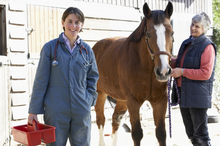Assisi Animal Health, developers of the Assisi LoopTM, a non-invasive and non-pharmaceutical healing and pain management device for animals, now provides information for horse owners about identifying and treating Equine Wobblers Syndrome.

Helping manage wobblers disease in horses
A horse with Equine Wobblers Syndrome may exhibit excessive knuckling of the hind legs when coming to a stop, and other symptoms include stumbling and abnormal wear of the front hooves.
Equine Wobblers Syndrome encompasses a number of neurologic conditions that all involve the compression and inflammation of the cervical spinal cord. A "wobbler" is a horse that has a wobbling gait due to compromised sensory motor input. Symptoms can be temporary or permanent, and can occur gradually or quickly. In most cases, the symptoms are symmetrical.
A horse with Equine Wobblers Syndrome may exhibit excessive knuckling of the hind legs when coming to a stop. Other symptoms include stumbling and abnormal wear of the front hooves. Horses with Equine Wobblers Syndrome often rotate their front feet outward when going uphill. Owners may also notice the presence of unusual sores from over-reaching.
There are three primary areas where Equine Wobblers Syndrome may affect a horse: the neck; the back and pelvis; and the brain and brain stem. In some cases, the condition affects several of these areas. A veterinarian can determine the location and severity of Wobblers by performing a series of tests during a neurologic evaluation.
Symptoms of Equine Wobblers Syndrome caused by brain lesions include impaired vision, difficulty eating and drinking, and head tilting. Brain lesions primarily result from an infectious disease, trauma, parasite migration or tumor.
If neck lesions develop, the horse typically has issues with all four limbs. The most common neck problems are cervical vertebral stenosis (CVS), cervical vertebral malformation (CVM) and degenerative joint disease (DJD). Issues with the back and pelvis usually involve equine degenerative myelopathy (EDM) and are typically identified through spinal radiography.
Treatment for Equine Wobblers Syndrome depends on the severity of the condition. Veterinarians score neurological signs on a five-point scale. At level five, the horse is unable to stand. Some horses can improve with nutritional intervention and medical management, while others require extensive physical therapy or surgery. The Assisi LoopTM may also be used to treat the symptoms of Wobblers.
Assisi Animal Health's clinical solutions help veterinary professionals and pet owners improve the quality of life for animals using the non-invasive, non-pharmaceutical healing device that is based on the same FDA cleared technology used on humans. The Assisi Loop uses low-level pulses of electromagnetic energy to reduce pain and swelling, and to enhance recovery. Proven Science. Positive Results. TM For more information visit the Assisi Animal Health website.
